Reader Question: We just sold our home after struggling in the market. We never realized when we bought the house we had a built-in “objection” (food plant a couple of blocks away discharged an odor). We will buy another home and wondering if there are other “objections” to be alert for after missing it in our first home. Thanks. Aaron and Sherry P.
Monty’s Answer: Be alert for these common “red flags.” The term “red flags” does not mean do not buy this property, or, the property cannot sell. It means stop and consider the impact before moving forward. Knowing the effect the flaw has on the value is important.
Flaws are sometimes hard to see
These flaws can involve issues with a segment of buyers coming to look. Most property, even with limitations, can be an excellent value if priced accordingly. Here is a list of “red flags” that can influence the price a buyer will pay for a house. This list is not all-inclusive, yet potential buyers and sellers can utilize it to raise their awareness of similar conditions. The same red flags that allow you a “great value” may still be there when selling in the future.
The Common “Red Flags”
1. Future of the Area – Are home values increasing or decreasing in the general vicinity? Be sure the neighborhood information you receive is accurate and current by checking with the source.
2. Local School System – Although you may not have school age children, the school’s reputation may affect demand for your home in the future.
3. Economic or other Factors – Local or neighborhood economic factors like increased property taxes, labor strikes, plant layoffs, and more can affect a home’s value.
4. New Subdivision – Ask the developer to see specific plans for the development of the remaining lots. Developers sometimes have external factors that force them to sell, change, or abandon their plans. Are the restrictive covenants recorded at the courthouse?
5. Vacant Land – Vacant land always presents the risk of the unknown. Regardless of the owner’s intent, that intent and zoning can change with time and circumstances.
6. Adjacent Property Features – Neighboring property may have a bearing on a home’s future sale potential. Ask yourself if the price is consistent with neighborhood variables like condition, overcrowding, zoning compatibility, junk in the yard or other unusual circumstances.
7. Floor Plans and Amenities – Oversized rooms and odd floor plans are viewed as inefficient use of space. Does a two-bedroom home fit into an area of mostly three-bedroom homes? A home with a bedroom entered through another bedroom is evaluated differently.
8. Over Investing – Homes with luxurious and extravagant decor or amenities, or homes that are larger than the other homes may limit the value of the investment.
9. Flooding – Be aware that property on a lake, river or in a flood plain zone is susceptible to flooding and recurrences of water damage, inconvenience, and danger, all of which can limit marketability.
10. Additions – Older homes with new additions or remodeling may not cause concern but be aware of floor plans and over investing. Incomplete construction or incomplete restoration can change the value of the property.
11. Poor Construction or Condition – Check the quality of building materials and workmanship like miter joints, door frames, mop boards, consistency in plastering, woodwork, and painting. Also, check major parts like the roof, off-brand HVAC systems, support beams and equipment operation.
12. Extended Market Exposure – What is keeping people looking from buying it? Is it just price? Ask the agent for a copy of the property’s listing history for the past five years. A neighbor can also be a good source for information.
13. Negative Environmental Concerns and Hazards – Leaking underground storage tanks, asbestos, urea-formaldehyde foam, radon gas, waste disposal sites and even busy streets are a matter of known information in neighborhoods.
OK, So Now What?
Buyers should weigh the factors above carefully if one or more are present in the home. The more “red flags,” the greater effect on the value. There is no such thing as a “perfect” home, also remember the seller may have already taken the “red flags” into consideration in determining the asking price.
Sellers with a “red flag” should be alert so as not to overprice the home. Remember that there is a buyer for every home. Objections often melt away with price reductions. Price cures all deficiencies. The real trick is not to get excited and over react.


Leave a Reply
You must be logged in to post a comment.